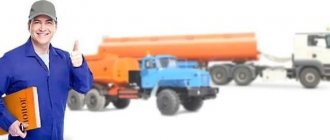What to carry?
The most convenient way to transport any of the devices mentioned is to place it in the back of a pickup truck or minivan. This way you are practically unlimited in speed, while with a trailer on the highway - up to 90 km/h and on a regular road - up to 70 km/h.
Without a trailer, aerodynamics are better and, accordingly, fuel consumption is lower. And the cross-country ability is higher, which is important in the “last mile” before the target. It is more convenient to secure cargo in the back of a pickup truck, since there are usually mounting eyes there. Some trailers, for example, do not have them. But if you can’t do without a trailer, pay attention to the following two points.
We are on Twitter:
Login Registration
Automotive news
Rules for the movement of heavy trucks in the automatic weight control zone have been adopted. The Federal Tax Service has approved the application form for the death or destruction of a vehicle. In Russia, it is forbidden to disembark children without a ticket from buses. A new sign 6.22 has been introduced in the traffic rules - “photo and video recording” Testing for alcohol dependence has been postponed for another year. The Ministry of Health has updated the requirements for completing car first-aid kits, the Ministry of Transport has approved the procedure and terms for storing diagnostic maintenance cards. Obtaining permission for international transport will now be done in a new way. You can now check your MTPL policy for authenticity online. The Central Bank has set new tariffs for MTPL.
/ Legal articles on automobile law / Traffic and safety issues / Rules for transporting goods on a passenger trailer
Rules for transporting goods on a passenger trailer
A trailer is a vehicle, not equipped with an autonomous engine, used for the transportation of goods in conjunction with a motor vehicle. A passenger trailer also belongs to a full-fledged vehicle, and therefore, its improper installation or operation can lead to a threat to the safety of road users.
Parameters of trailers for passenger cars
When driving with a trailer, the car plays the role of a tractor, and the trailer is attached to it using a rigid connecting element - a towbar, which is equipped with electrical wiring and a plug socket. The trailer is equipped with lighting devices: turn signals, brake lights, side lights.
For any type of vehicle, the maximum permissible weight of a loaded trailer is established. If this value is less than 750 kg, then the driver can drive with category “B” (categories “C” and “D” are also allowed). It is allowed to use a trailer with all vehicles of category “B”; its weight should not exceed the weight of the car.
When choosing a trailer, you need to take into account the intended scope of its use. The following types of operation are most typical for passenger cars:
— It is planned to transport building materials, furniture, and use them for other household needs;
— Transportation of snowmobiles, hydro- and ATVs;
Driving with a trailer
When overtaking and braking, it should be taken into account that the presence of a trailer causes a decrease in acceleration dynamics and an increase in braking distance, therefore:
— Braking should be done smoothly, even when there is no load;
— It is necessary to keep a distance from the car in front, and when you need to slow down, you need to do it gradually;
— If you need to turn, you need to start slowing down in advance; turns are driven “pull”. You need to brake without jerking, as this leads to the trailer and the car skidding or “folding”, since when turning, the radius of movement of the trailer wheel is less than the radius of the tractor wheel;
— Maneuvering, changing lanes in traffic and parking are difficult, especially within the city. Particular care is required when driving in reverse, especially with a trailer with a high awning. At increased speed and too much cargo, the trailer begins to swing to the sides;
The amount of fuel consumed when driving with a trailer does not increase noticeably. Typically, the increase in consumption is 5-15% depending on travel conditions and cargo weight (the higher the weight, the higher the consumption).
Paperwork
The trailer must be registered with the traffic police as an independent vehicle, receiving a separate certificate and license plate.
If the owner of the trailer is an individual, its technical inspection is not considered a mandatory procedure; this is only necessary for organizations.
At the request of the traffic police officer, the driver of the car, together with the documents for the car, is obliged to provide registration documents for the trailer.
Travel speed with a trailer and methods of marking the load
In accordance with traffic regulations, the maximum permissible speed for driving with trailers, compared to driving without trailers, is reduced by 20 km. and amounts to:
— 70 km/h on regular roads;
— 90 km/h – on highways;
The distance from the top of a loaded trailer to the road surface should not exceed 4 m, the width of the load cannot be more than 2.55 m. The load at the rear is not allowed to protrude more than 2 m.
If the load protrudes beyond the dimensions of the vehicle by 1 m in front and behind, or by 0.4 m on the side of the side light, it is necessary to install the “Large Load” sign. In addition, at night or in case of poor visibility, red lanterns or reflectors are installed behind, and a white lantern or reflector is installed in front.
If the dimensions are exceeded, the tractor must be equipped with rear-view mirrors on extended brackets.
Download Features
It is prohibited to transport people on cargo trailers or caravan trailers. The weight of the load and its distribution along the axes should not exceed the volumes established during manufacture.
The driver’s responsibilities include placing, securing and securing the cargo so that it does not fall out while driving and does not create interference for road users.
When placing the load, it is necessary to ensure its uniform distribution, and the center of gravity must fall on the axle (if the trailer is single-axle) or axles (if the trailer is two-axle):
If the center of gravity moves forward, the load is placed on the hitch point and the rear of the vehicle, resulting in reduced traction between the front wheels and the road.
If the center of gravity is shifted rearward, it causes the rear of the vehicle to lift and reduce traction between the rear wheels and the road.
The load should not block the driver's view, interfere with control, or disrupt the stability of the vehicle; lighting devices should not obscure hand signals. In addition, the cargo must not pollute the environment.
Be sure to carry chocks (2 pieces) with you to install under the wheels when stopping on sections of the road with a slope.
Before driving, it is the driver’s responsibility to check the technical condition of the vehicle, in particular:
— Checking the presence of lubrication on the tow bar;
— Check for play between the coupling ball and the assembly. If play is detected, it must be eliminated;
— Checking the tire pressure level;
— Checking the reliability of the connection between the safety rope and the chain;
-Checking lighting devices;
It is prohibited to drive if there is a malfunction of the brake or clutch system, a problem with the steering, a malfunction of the headlights and side lights, or a windshield wiper on the driver’s side.
During the journey, the driver is also obliged to ensure that the vehicle is in good working order in full compliance with the rules of safe movement. It is prohibited to make changes to the design of the trailer without the approval of the traffic police.
That's all, good luck on the roads!
Vehicles of category M1
Vehicles not subject to categorization
trailer
18053
No comments yet. Yours will be the first!
Write a comment
New comments
Badyrgy → Removal and expungement of a criminal record under Art. 264.1 of the Criminal Code of the Russian Federation 21 hours ago
Convicted in 2014 of Part 1 of Article 264 of the Criminal Code of the Russian Federation with restriction of freedom and deprivation of rights for 1 year. How to expunge a criminal record? And where to go
Vladimir → Is it necessary to give way to a bus leaving the bus stop… 15 days ago
The rules state that the driver must give way to a bus departing from a stop within the city limits, but I drive at a speed of 60 km per hour at the main speed...
Automotive Lawyer → Deprivation of the right to drive under Art. 264 of the Criminal Code of the Russian Federation. About the most... 1 month ago
Hello. The period of criminal punishment in the form of deprivation of the right to drive runs, regardless of whether the vehicle is passed or not. The traffic police have been punished for enforcing this...
Evgeniy → Deprivation of the right to drive under Art. 264 of the Criminal Code of the Russian Federation. About the most... 1 month ago
Good evening! In 2014, he was convicted under Part 264 of the Criminal Code and served a real sentence of 2 years in a penal colony; the court also deprived him of his license for 3 years, after...
Automotive Lawyer → Deprivation of the right to drive under Art. 264 of the Criminal Code of the Russian Federation. About the most... 1 month ago
Hello. The terms of deprivation under the article of the Code of Administrative Offenses of the Russian Federation and under the article of the Criminal Code of the Russian Federation are not cumulative. Each term is calculated independently, i.e., independently of each other
Category on driver's license
The vast majority of car owners in our country have a category B driver’s license, which allows them to drive vehicles with a gross weight not exceeding 3.5 tons. The Federal Law “On Road Safety” (Article 25) allows a driver with category B to drive category B vehicles with a trailer in two cases:
- the maximum trailer weight does not exceed 750 kg;
- the maximum mass of the trailer exceeds 750 kg, but does not exceed the unladen mass of the vehicle, provided that the total permissible maximum mass of such combination does not exceed 3500 kg.
Features of the development of the Russian road transport market.
Transport infrastructure is different in different countries of the world. However, it is precisely this that largely determines the dynamics of the development of the road transport market. But besides this, there are other factors that influence how much this type of service will be in demand in each specific country. Russia has its own peculiarities in the development of the road transport market.
The development of the trailer and semi-trailer market largely depends on the dynamics of the development of the general road freight market and on the truck market in particular. For example, if in 2009 there was a slight decline in the overall cargo transportation market and a decline in key indicators in the truck market, then the production of trailers and semi-trailers by the end of this year was also reduced by approximately 60%. However, already in the last quarter of 2009 and at the beginning of 2010, the production of automotive vehicles increased slightly, possibly due to the positive dynamics that had developed by this time in the cargo transportation market. In any case, if this trend continues in the future, it will certainly subsequently affect the market for trailers and semi-trailers.
If we consider Russian manufacturers of trailers and semi-trailers, the main players in this market today are:
- OJSC NefAZ, which produces about 30% of this equipment;
- OJSC Autotrailer-KAMAZ, their share accounts for 20% of produced trailers and semi-trailers;
- occupies about 15% of this market;
- JSC Novtrak produces no more than 4%;
- the share of OJSC Uralavtotrails accounts for only 3%.
In addition, there is a fairly large amount of imported equipment on the Russian market of trailers and semi-trailers. The most popular brands here are products from Schmitz, which account for 35% of all Russian imports, and Krone, which sell more than 15% of all imports to Russia. Other manufacturers account for a significantly smaller amount of such equipment: Koegel represents only 5% of total imports, and Kassbohrer and Lamberet - no more than 3% and 2%, respectively.
If we talk about the types of trailers and semi-trailers, then currently the most popular on the Russian market are the tilt versions. Mainly, due to their versatility, they occupy about 45% of the entire market for such transport equipment in Russia. Refrigerated trailers and semi-trailers are in demand due to their highly specialized focus; they account for up to 20% of Russian equipment. Tanks and container ships account for 10% and 5% of the Russian market, respectively.
About the established rules for driving with a trailer
Recently, there have been constant changes or additions to traffic rules regarding various issues.
According to the new rules, a tow hitch is also a vehicle and in cases specified by law, namely for legal entities and when transporting goods over 3.5 tons, it must be registered, and the driver when transporting goods exceeding the total weight of 3.5 tons of the road train must have the appropriate category “E” on your driver’s license.
Container semi-trailer.
A semi-trailer container carrier is a highly specialized vehicle and is used for transporting sea containers from the container site of the port of arrival to the destination of the cargo. At the same time, a standard semi-trailer container carrier, with its length of 12.5 meters, width of 2.5 meters and loading height of 1.4 meters, can transport a total cargo weighing up to 31 tons, this is usually one 40-foot container or two 20-foot ones.
In addition to standard container semi-trailers, there are also low-bed options. They differ not only in their dimensions (length 12.6 meters, width 2.5 meters, loading height 1.1 meters), but also in their carrying capacity, they can transport 34 tons of total cargo. These semi-trailers can accommodate either two standard 20-foot containers, or one high 20-foot container, or one 40-foot container.
What you need to know when transporting a boat
Transfer of small vessels by road has its own characteristics and requires compliance with basic rules. What specific vehicle will be needed for movement will directly depend on the weight and size of the vessel. As a rule, yachts and boats are classified as oversized cargo. Objects that have the following parameters are classified in this category:
- Length – 20 m;
- Width – 2.55 m;
- Height – 4 m;
- Weight – 38 tons.
Transportation of yachts and boats, which are regarded as oversized cargo, requires compliance with the following traffic regulations:
- Obtaining permits from the State Traffic Inspectorate;
- Use of special transport appropriate to the parameters of the vessel;
- Development of the route and coordination with government agencies controlling the route.
Cargo transportation of this type of cargo requires a professional approach from the carrier, as well as attentiveness on the part of the owner. It is necessary to calculate all the points in order to successfully carry out the transfer without damaging the ship.
Is it possible to pay a fine for oversized cargo at a discount?
The fine for transporting oversized cargo, like many other traffic police fines, can be paid with a 50% discount. If organizations have imposed a sanction at the upper limit, it is 250 thousand rubles. To receive a discount, you must pay the fine within 20 days from the date the resolution comes into force. It is important to consider that the letter with the resolution may not reach the recipient. Therefore, it is important to monitor the occurrence of such fines as soon as possible.
The online service for monitoring fines for legal entities onlinegibdd.ru . The service monitors the occurrence of any fines of the organization through the state information system, to which individuals do not have access.
according to article
Write to our lawyer and he will help you understand automobile legislation. We will consider controversial situations and tell you how to act according to the law.
Don't miss new useful publications
We will tell you about the intricacies of the legislation, help you understand it and tell you what to do in controversial situations.
Great!
We sent you a selection of interesting articles about important changes in legislation by email.
Source
Fine for oversized cargo
The amount of fines for violation of the requirements for the transportation of oversized cargo is established in Article 12.21.1. Code of Administrative Offenses and depend on the amount of excess of norms.
When choosing the size of the punishment, the court will be guided by the degree of exceeding the permissible dimensions.
During inspection, the inspector measures the vehicle in length, width and height with a telescopic ruler or tape measure. The tool must be certified. If the inspector detects a violation of acceptable standards, he draws up a report and a protocol on the administrative violation, and the vehicle can be sent to the impound lot. Responsibility for the violation will be borne by both the driver and the organizers of the transportation: officials and legal entities. In relation to the latter, Rostransnadzor is obliged to conduct an administrative investigation and, on its basis, issue a decision on non-compliance with the permissible dimensions of the vehicle.
If sanctions are imposed unfairly, they can and should be appealed.
Checking fines for legal entities. persons
Monitor fines, receive a daily report on new fines found and pay them automatically
Universal trailers.
Non-specialized vehicles that are intended for transporting goods for various purposes usually include universal trailers, as well as flatbed semi-trailers.
A Jumbo semi-trailer can be considered a type of universal semi-trailer. It is used for transporting complex or large cargo, the volume of such a trailer is 96 - 125 cubic meters, or heavy cargo (somewhere up to 24 tons). Thanks to its design, due to the reduced diameter of the wheels of the rear axle of such a semi-trailer and the L-shaped configuration of the floor (the floor is raised towards the cabin), it was possible to achieve a large capacity of such a semi-trailer.
To transport large volumes of cargo over long distances, usually between cities that are located far from each other, universal trailers - trucks - are used. The capacity of such a trailer can be from 55 to 120 cubic meters, and the load capacity is up to 24 tons. As a type of truck, we can consider the so-called Eurotruck (tilt semi-trailer) with a carrying capacity of 20 tons, the capacity of which is 33 pallets. A special feature of the Eurotruck is that for the convenience of loading and unloading operations, its side pillars and side walls can be removed.
Another type of universal trailer can be considered. As a rule, these are a trailer and a semi-trailer connected together, or two trailers. This allows you to transport fairly large cargo volumes, up to 120 cubic meters.











